This week I have been mostly reading....
As part of my research into the Raitt family, I have done a fair amount of background reading in an effort to understand the history, geography, archaeology and the times and changing environment in which our ancestors lived. How did the earliest ones survive in turbulent times - what happened when they were forced off the land in the Clearances? Many were agricultural labourers - so what was involved in farming in the eighteenth and nineteenth centuries? Others were flax dressers - so what did working in the linen and jute industry entail? What of those who were master mariners? What was it like to sail the world in a three-master schooner in the early 19th century? What were the social conditions of our ancestors, what about education, what changes did they witness during their lives, how was life before it was eased with the coming of the railways and later cars?
So, here you will find, from time to time, brief summaries of some of the books and articles I have been reading in an attempt to find some of these answers. The information given should not be construed as a review or critique of the book - I mostly give an overview of what the book contains and point to some pertinent passages that are interesting or helpful to my research.
The new books are added at the bottom of this page. This is because although the text moves down automatically if I add something above it, the images associated with the text do not and so I have to move them all down manually.
In addition to the books, there are also a number of pertinent Web sites (other than the familiar ancestry ones) that give good, useful background too. And so for your edification and interest I will provide details of those I have found particularly relevant in my research on that page.
*****
The Scottish Countryside: its changing face, 1700-2000
Rosemary Gibson
John Donald, 2007
The Introduction to this book starts off by announcing that the rural landscape we see today is largely a man-made creation. The Scottish countryside has changed dramatically over the years. Three hundred years ago – at a time when my earliest known direct ancestors were living and working – the landscape was fragmented, with clusters of small farms, narrow strips of cultivated ground, few trees, no hedges, extensive moorland and bog, and only tracks for roads. By 1850, though, the landscape was regular and ordered, with larger farms, enclosed fields, plantations, expanding villages and a growing network of canals, roads and railways. Rural industries, new methods of farming, better housing, improved transport, availability of water and electricity, as well as changes in land ownership have all combined to bring about significant changes to the landscape. This book makes use of the extensive holdings of the National Archives of Scotland (formerly the Scottish Record Office) of over 100.000 plans to illustrate, together with photographs, the great changes wrought on the face of the country over the past three centuries.
The book has eighteen chapters covering such topics as the Old Face of the Country; Homes and Gardens; Common Lands and Enclosure; Drainage and Tree Planting; Rural Housing; Rural Industries including Mining; the Highland Landscape; Planned Villages; Roads, Bridges, Canals, Railways, Harbours and Lighthouses; as well as Water, Electricity and Forestry. Each chapter is nicely introduced with history, facts and discussion and then illustrated with selected plans which show, for instance, how the division of commonty worked or how the laird’s estate was made much grander at the expense of the local worker’s cottages. In each case, the plans are commented on in detail. We learn, for instance, that the lack of decent roads in Scotland was a frequent traveller’s lament. Paved roads existed only in towns; most routes were beaten tracks worn by centuries of use; most routes were impassable to any wheeled vehicle such as a carriage; bad weather turned them into quagmires. Indeed, the average man could travel across such country at a speed of no more than one mile per hour (compared to the 3.5-4 miles per hour that a brisk walker can achieve today on an optimum surface.) this is clearly one reason why people did not stray too far away from where they were born whether for work or to marry.
The book has extensive notes, an excellent bibliography on all the main topics, and a good index. It is a very readable book that gives a wonderful insight into the changes our ancestors witnessed and how they must have been affected by them. Furthermore, it shows the places on the laird’s estate that they will have lived in, the tracks that they used to move between scattered communities, the way the land they farmed was divided up and the crops that were planted by them. I bought the book because I wanted to know more about my forebears and their environment and conditions. I was not disappointed!
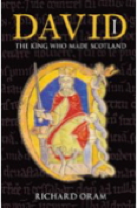


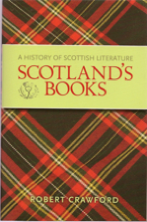


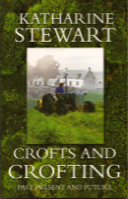
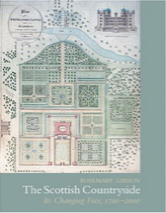
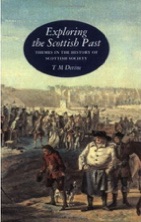
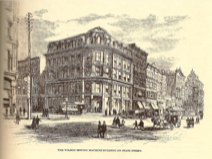
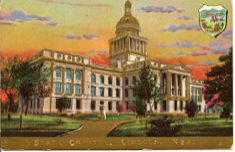
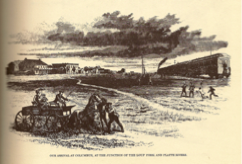
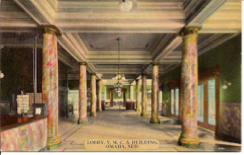
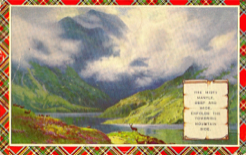
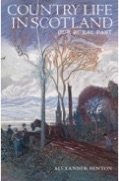
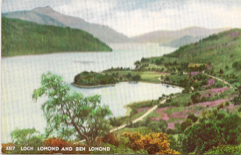
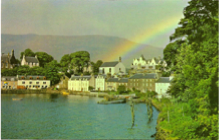
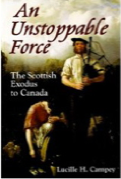

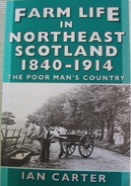
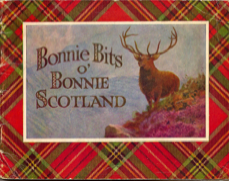
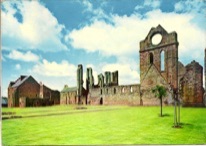
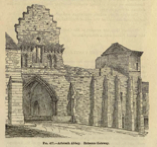
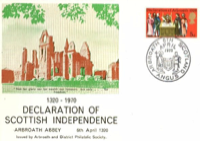
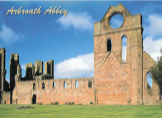
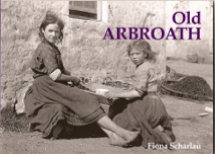
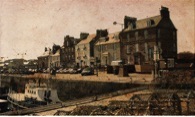
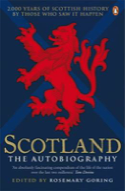
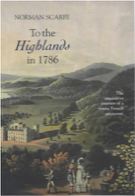
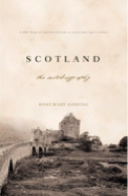
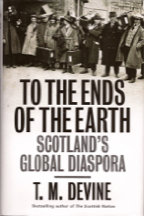
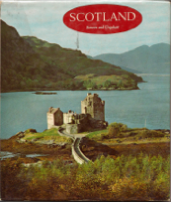
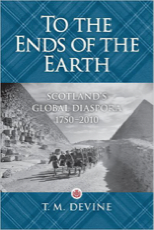
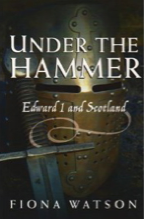
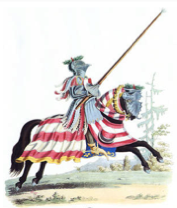
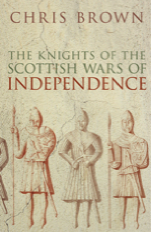
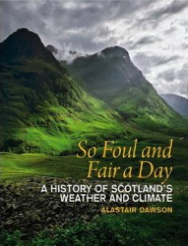
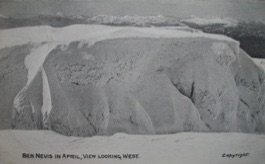
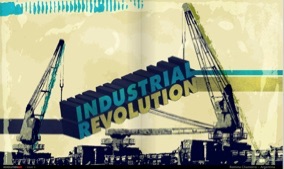
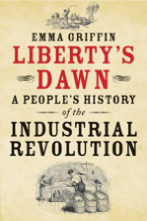
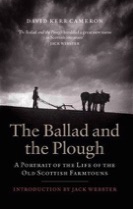
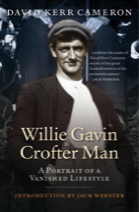
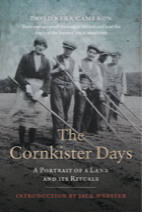
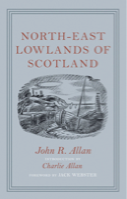
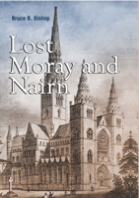
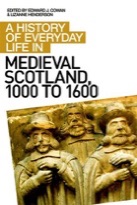
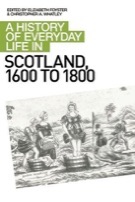
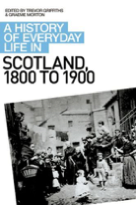
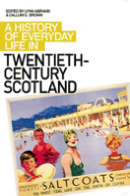
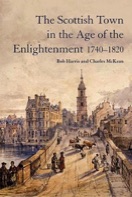
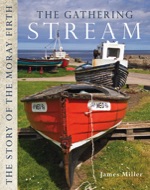
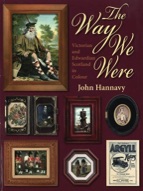
The Scottish town in the age of enlightenment 1740-1820
Bob Harris and Charles McKean
Edinburgh UP, 2014
This substantial tome, copiously illustrated with maps, photos, figures and tables, is all about the profound transformation in the nature of the urban environment and urban society. It explores the development of the Scots burghs and their changing material cultures, regulation and cultural life. In 1740 many Scottish towns were in a pretty sorry state, lagging far behind countries such as Italy, The Netherlands and even England. However from this time on, against a background of accelerating economic revitalization, urban dwellers began to systematically implement programmes for improvement of their townscapes. Although there was a gradual convergence on Anglo-British norms, the burghs and urban societies still managed to retain a distinctive Scottish character.
What makes this very readable book more interesting us is that it focusses in particular on two regions that saw rapid urban growth from the mid-eighteenth century, one of which is Angus and Perthshire. Thus, although, many burghs throughout Scotland are covered, much attention is given to places we are familiar with because our ancestors lived there during this time: Arbroath, Brechin, Cupar, Dundee, Forfar, Montrose and elsewhere. We learn when such towns laid plans for supply of spring water into the town, how complaints about streets not being kept clean were resolved by providing guidelines for dunghills, where flesh and slaughterhouses should be located, how ruinous houses and outside stairs and lean-tos were pulled down, the prohibitions on certain combustible materials being placed near heat sources and the regular cleaning of chimneys, why and when paving was introduced in the streets and streets were widened, when lighting in streets was first introduced, what the rules were for building structures and repairing bridges and harbours, and other general but important regulations for carters, for example.
In two parts: Towns and Improvement and Society and Culture, the book is divided into seven chapters. The first provides a framework for what follows and how Scottish towns differed from one another, and indeed elsewhere in Britain. The next three chapters describe and analyse improvement as a process and feature of a growing number of Scottish towns in the 18th and early 19th century. Chapter 5 concentrates on the rebuilding of urban domestic architecture, while Chapter 6 examines the growth of cultural institutions and practices within towns. The final chapter explores the nature of civic order and identity during the period - how law and public order was established and maintained and how the problem of vagrancy was addressed. The Conclusion draws everything together and an appendix gives improvement profiles of the burghs covered in the book.
The gathering stream: The story of the Moray Firth
James Miller
Birlinn, 2012
I bought this book for two reasons: my paternal grandmother’s family came from Banffshire on the open sea coast of the Moray Firth; and Sir Gervase de Rathe had his castle at Rait, near Nairn, much closer to the narrowing of the firth. So what could I learn about the environment in which my ancestors were established?
The Moray Firth, the largest firth in Scotland - called Breidafjordr by the Vikings and Linne Mhoraibh by the Gaels - has had a dramatic history over the last 2000 years. Its land was trodden by Roman feet, it was once a Pictish power centre, and the coastline became a region contested by Gaels, Norsemen, Norman knights, royal dynasties, and local clan chiefs who sought to gain control of its fertile soil, its grain and timber, cattle and fish. Later burgh merchants battled to maintain trade links with the rest of Britain and Europe.
This well-written and lavishly illustrated book covers these two thousand years - starting out with the Roman incursion and their battles with the native Celts. The next chapter deals with the emergence of the Pictish nation, while the third discusses the invasion by Gaels and Norsemen. Subsequent chapters covers the forging of the province of Moray and the establishment of burghs and fiefdoms under David I. Disasters in the Scottish succession led to occupation by Edward I which in turn led to greater divergence between Highland and Lowland outlooks, as well as the struggles between church and state. These shifts in Scottish history and culture had their impact on the shore lines and peoples on both sides of the Moray Firth and this too is explored.
Sadly, although Nairn (and its Castle) is mentioned many times throughout the book, Gervase and Rait Castle is not - however, this does not detract from a very interesting and readable book!
The way we were: Victorian and Edwardian Scotland in colour.
John Hannavy
Whittles Publishing, 2012
This nice book looks at how Scotland was depicted in photographs and postcards in Victorian and Edwardian times, thus some 100-170 years ago when our grandparents and great grandparents (in my case at least!) were living and working there. Although many images are in the Victorian-preferred sepia colour, many later ones are also either hand-tinted or in full colour. The postcard was a way of keeping in touch with family and friends - just saying hello or giving details of their trip or holiday. The subject matter of the postcards is wide and varied and sees people going about their daily lives (albeit often posed for the camera) whether working in the fields, catching a steamer, or journeying in open carriages enjoying the scenery. There are some twenty themes ranging from railways, world fairs, canals, industry, entertainment, working the land, textile industry, fishing, village life, family life, at the seaside and others. Each topic is discussed in the text and illustrated with copious images with explanatory captions. I personally love old photographs and postcards and this book was a delight for me to come across.
A History of Everyday Life in Scotland (series)
Edited by Christopher A. Whatley and Elizabeth Foyster
Edinburgh University Press, 2010-2011
I finally completed this epic four volume work on the history of everyday life in Scotland with some regret. The series demonstrates how everyday routines and behaviours can open a window into the social, economic and cultural lives of ordinary Scots. Each of the four volumes contains a collection of individually authored essays examining common topics such as landscape, homes, objects, rituals, beliefs, work and leisure, conflict and communications. Across the series there are some remarkable continuities in the subject of the topics as well as some wide divergencies over the centuries. Chapters cover illness and disease; death, birth and marriage; movement, transport and travel; sights, smells and sounds; women and the family; man about the house; religion; and much more. There is a vast array of notes and sources for each chapter. The everyday is shown to be shaped by national and regional surroundings and dependent on an urban or rural and lowland or highland setting.
Though each volume has the main title, there is also a subtitle for each. Thus:
Medieval Scotland, 1000 to 1600, edited by Edward J. Cowan and Lizanne Henderson (EUP, 2011)
Scotland, 1600 to 1800, edited by Elizabeth Foyster and Christopher A. Whatley (EUP, 2010)
Scotland, 1800 to 1900, edited by Trevor Griffiths and Graeme Morton (EUP, 2010)
Twentieth-century Scotland, edited by Lynn Abrams and Callum G. Brown (EUP, 2010)
To be honest I found these books to be illuminating, interesting, and not at all dry - indeed difficult to put down. I keep saying it, but books such as these really do provide fascinating insights into how our ancestors - including very recent ones - lived, loved and worked.
North-East Lowlands of Scotland
John R. Allan
Yeadons, 2009
First published in 1952, this book is billed as a classic introduction to the North-East from the North Esk to John o’ Groats which provides an informative yet intimate account of the area and paints a vibrant picture of this fascinating part of Scotland. Fishing and farming feature strongly, as does the story of the principal town, Aberdeen. What also comes out is the indomitable spirit of the people and their rich cultural life, particularly the songs and ballads for which the North-East is renowned. The book was originally written as a guidebook with each county from Kincardineshire to Caithness being treated from the earliest times and from south to north. Allan tells of illegal stills - one of which was adapted to the central heating system of the local church, only discovered by the exciseman because of the strong smell of whisky in the church - of squatters driven further up into the hills, how folk survived the Depression by eating locally-landed fish and chips from locally grown potatoes, of lads who left the land behind to go to university. There are chapters on ballads, the supernatural, pastimes and cattle shows - all part of the fabric which made the North-east of Scotland a unique part of our ancestors’ life and thus our heritage.
Lost Moray and Nairn
Bruce B. Bishop
Birlinn, 2010
In this book, Bishop traces what has been “lost” from the old counties of Moray and Nairn, both architecturally and socially. With illustrations and old photographs of places, buildings and aspects of life that have since vanished, he demonstrates not only how the burghs of Nairn, Forres and Elgin have evolved over the centuries, but also shows how changes have affected smaller towns and villages. He explores those elements which have been lost from coastal towns and the more recent decline of the fishing industry. From prehistory to the present day by way of the Picts, Romans and Vikings the author examines topics including geology and the changing coastline; architecture of castles, mansions and religious buildings; the royal burghs; agriculture and industry; and communications via roads and railways. This is another useful book for those wanting to learn more about the environment which saw the emergence of our earliest putative ancestors Sir Gervaise de Rait and his brother Andrew.
[Farming way of life in North-East Scotland - trilogy]
David Kerr Cameron
Birlinn, 2008
David Kerr Cameron was brought up in Tarves, Aberdeenshire, and as a child witnessed the tail-end of a farming way of life in North East Scotland which has now virtually disappeared, but which many of our own ancestors were themselves part of. The son of an horseman, who moved from farm to farm in the pattern of the time, Cameron wrote a trilogy of books in his fifties about Scottish rural life in a bygone age. Together they give a vivid picture of the way of life which was both hard and unrelenting, yet filled with community spirit.
Life was based around the fermtoun - a structure of big farms that were almost like small towns in their own right. Each employed twenty or more men and women, who together with their families (nine or ten children were not uncommon), made a sizeable community. Wages were minimal, the pace and manner of work was tough and seasonal, the daily rural routine could start as early as 4am, breakfast and virtually all other meals consisted of monotonous permutations of various dishes comprising oatmeal - and so life was a struggle in a landscape from which people found it almost impossible to escape, even through marriage. Stories and ballads reveal the lives and characters of those dedicated or tied to the land.
The first book in the trilogy is The Ballad and the Plough: A Portrait of Life of the Old Scottish Farmtouns (first published 1978). It tells you everything you need to know about how life and work and relationships in North East Scotland were conducted: the pattern of work, the farmtoun crew and the iron hand of the grieve (farm overseer), the horsemen (in a class of their own), the shepherds, the women in the touns, the bothy lads, the fairs where men and women sought work, the trysts, the meals and social occasions, the importance of the kirk, the implements used, the harvests, the arrival of steam and factories.
The second book, Willie Gavin, Crofter Man: A Portrait of a Vanished Lifestyle (1980), reveals the hardships of those who struggled to work a barren and inhospitable landscape as well as the joys brought by events such as weddings and festivals, though the eyes of Willie Gavin. Another integral component of the Scottish rural scene was the crofter, who was at least his own boss even though his work was no less hard or more financially rewarding because of this. The crofter had his own little patch of lonely moor with his own little hovel build upon it by his own hands. The story unfolded by the pages of this book show how the crofter and his family had to keep pace with the seasons and what they relied on for food and how they could make some money selling what they grew or raised or by becoming weavers or masons as a sideline. It also notes the friendships among a toughened people who helped each other out in times of sickness or particular hardships.
The last book of the trilogy is The Cornkister Days: A Portrait of a Land and its Rituals (1984) which recalls the days of the cottar and crofter, and laird and tenant. The various chapters cover the land and the folk who worked it, the place and role of the laird who owned the land, the patterns of the year - ploughing in winter, harrowing, harvest, the autumnal days, the time of the potato, the horseman’s word, the lore of the land, byres and bailies, and laments for a lost landscape and way of life.
These three books were each marvelous reads for someone whose maternal great grandfather was a grieve, and whose other putative relatives were farmers, weavers, masons and the like and whose time and place was that of the trilogy. Important works documenting the history and geography of a mostly forgotten way of life, these three books, with their many old photographs, give a unique insight into how many of our ancestors lived and worked.
Liberty’s dawn: a people’s history of the industrial revolution
Emma Griffin
Yale University Press, 2013
Nearly 1000 autobiographies of 18th and 19th century working class people are known to exist, mostly in printed form, though some are manuscripts and there are probably many more waiting to be discovered in archives and attics. They encompass life histories, memoirs, sketches, diaries, notes, recollections, adventures, experiences and the like of an individual, usually a man, and written later in his life. The testimonies depict the every day life (including childhood) and work of the person, their hardships and sorrows, their relations with parents, spouses and masters and though they might be subjective and coloured by certain perhaps poorly remembered or particularly extreme circumstances or events, they nevertheless offer a fascinating insight into life back in the day.
What Emma Griffin has done is to examine and analyze over 350 of these autobiographies (the term was not in fact coined until long after many of these life-writings had been published) in order to offer an intimate first hand account of how the Industrial Revolution was experienced by the working class – as see through their own eyes - and what was the impact of the changes it brought on those who lived through it. Contrary to the view that the industrial revolution generally brought misery and poverty because it deprived the poor of their traditional livelihoods, and forced them to work for long hours in poor conditions for low wages, Griffin shows how the root of poverty was not industrialization itself, but rather the absence of it. The difficulties experienced by most in earning a living in cold, winter months were timeless and universal in pre-industrial Britain. Industrialization, in fact, raised incomes, provided long term employment, improved literacy and offered opportunities for political action. Of course, a thousand individuals, who were literate and motivated enough to write down the stories of their lives for whatever reason, out of a work force of millions, probably cannot be considered as really representing the whole – but there is every reason to believe that these personal stories, in their own words, are indicative of the conditions experienced by others. And even if they are not, there is still great scope for imagining that our ancestral relatives would have lived similar lives.
Emma Griffin’s book is in three parts, following an extensive introduction.
Part I, Earning a Living, comprises three chapters devoted to the man at work; the children who worked; and the women, some of whom worked but who mostly took care of the home and children. Part II, Love, covers courting, marriage and children with all the ups and downs of sex and family life. Part III, Culture, discusses in three chapters education, religion and the new-found sense of freedom people found. The book ends with a Conclusion, extensive notes, a bibliography listing all the manuscripts and printed autobiographies consulted, and an index.
The starting point for her research was what was the impact of the world’s first industrial revolution on the ordinary men, women and children who lived through it? Something momentous happened between the middle of the 18th century and the middle of the 19th. At some point, Britain stopped trying to make all its goods by hand and started to burn fossil fuels to drive machinery to do the work instead. Perhaps it was inevitable progress. But in the process, large numbers of families gave up working the land and moved to towns and cities to take up employment in factories, mills and mines.
The writings of the authors examined by Griffin reveal that in the absence of industry, most workers were not fully employed all the time and as a result lived in a perpetual state of poverty. Even skilled artisans such as shoemakers, blacksmiths, carpenters and the like were rarely able to make a good living from their trade, because few of their neighbours had the means to pay for their services. As a result, many skilled craftsmen turned to agriculture or small-holder farming to make ends meet and thus living standards remained low. The advent of the industrial revolution increased the amount of work available for all – skilled and unskilled, male and female, young and old. And as manufacturing expanded, so people flocked to the cities from the countryside to work in the new factories. Not only did the factories provide work for legions of workers, they also required construction, fuel and raw materials; and the workforce in turn required housing, food, furniture and clothing which created more employment for others.
More often than not, work started in childhood and continued for as long as one had the health to perform it. We can see this from the experience of our early ancestors: going to sea at 10 or 11 as ship’s boy, or working a handloom as a young girl; and, when the body wore out and some work was too strenuous, then doing something less arduous like becoming a carter – but even then still working to well over 70, even 80, if they survived that long. However, it seems that children in the countryside started work on average a couple of years later than those living in a city or industrial area.
Men were the main family breadwinners (even if they drank most of their pay) and had to take up the hardest, dirtiest and dangerous occupations. But they had certain compensations: the possibility of learning skills, earning better wages, attending night school or improving one’s status. Such rewards of work were not forthcoming for children and paid employment for women did not fit easily with running a household with numerous young offspring. Women living in the industrial areas did have increasing work opportunities, benefiting from the growth of factories, but once they were married with a family, few were able to maintain a position in a factory and most left the workplace altogether. Some tried working from home – bobbin winding, baking, washing – but once they had several children then few could maintain such paid work. On the other hand, unmarried women and those with no children almost always worked outside the home.
Increased work opportunities fuelled by the industrial revolution led not only to increased family incomes, but also to increased freedom, particularly in the burgeoning towns and cities. Many people attended night school in an attempt to gain better education which could further them. People were free to go – and went - to whichever church and denomination they felt suited their beliefs. It became possible to join unions and political associations – thus helping to shape the community and society in which they lived. The outcomes of the industrial revolution were thus mixed – healthy, adult men stood to gain the most through more jobs, higher wages and opportunities for cultural and political expression. Women were pretty much bypassed by these developments, and though children were exploited by the great demand for labour, the results for them were less beneficial.
As we can realize from looking at our parents and grandparents, each generation lives longer, enjoys greater material comforts, eats more varied and exotically, has more possessions, and works, communicates, lives and travels as a result of new technologies, than the generation before. Some changes are small and some are large – but they are all progress. And whether today we are more happy or even better off than our ancestors may be a moot point in some instances.
This is a most readable book, hard to put down, which analyses and explains much of the situation and condition of people who could be considered as the ancestors of all of us. Although in this “column” I don’t normally do proper reviews, I recommend this book to anybody interested in the lives of earlier, ordinary people. Even though it does not cover many Scottish autobiographies, the book still puts much into context for us and provides fresh insights. For instance, although many of my ancestors were weavers, others were journeymen practicing a certain trade and it is noticeable that they moved from place to place. With the realization that such skilled craftsmen might find it hard to survive if people in the local people could not afford to buy their products, then a new understanding has been gained. Similarly, many of our ancestors were classed simply as labourers in the censuses – some were agricultural labourers, but this was seasonal work – so they probably just weren’t digging ditches or planting crops most of the time, but were perhaps also involved in building work (factories and houses) or working on roads or railways. And it was enlightening to read that the pay of labourers as a whole was not too bad. Emma Griffin’s detailed account has given me a different impetus and opened up so many other avenues to pursue to a greater extent than I have up to now! I shall be exploring our Raitt ancestor lives based on what I have understood by reading her book and will write up my analysis in at least a blog entry.
So Foul and Fair a Day: A History of Scotland’s Weather and Climate
Alastair Dawson
Birlinn Ltd, 2009
This fascinating book traces, for the first time, the history of climate conditions and weather in Scotland by referencing a wide range of historical records, from medieval chronicles and diaries through to the newspapers of the present day. Dramatic changes in both climate and weather from the earliest times have helped shaped Scotland to what it is today – a fact often overlooked by historians. Scotland’s weather has not only imprinted itself on the country’s landscape, flora and shoreline, but also – just as importantly - on its people and culture. As it notes in the Foreword, “The more we know about weather in the past, the more we are likely to know about why we are as we are, why we live in the way we live and why we may have to adapt our lifestyles in the future!”
The book is divided into four parts, the first of which, Weather and Climate Change, gives a basic introduction to how the various components of climate and weather work and interact. This part covers, in easy to understand detail, the structure of the Earth’s atmosphere (what it looks like and what it consists of); the changing motion of the Earth in space (the characteristics of its orbit around the sun and how these processes affect weather and climate); the dynamics of the Earth’s atmosphere (how the movement of air masses affect us); and the circulation of the North Atlantic Ocean (how this affects weather and climate.)
Part 2 tackles Prehistory – particularly the various ice ages. Acknowledging that much of the explanation for several million years ago is largely guesswork, the author goes on to consider the separate ice ages Scotland went through as revealed by ice cores. The last glaciers disappeared from Scotland some 11.000 years ago with settlers making their first appearance (or possibly even a return) some time after that. Again, although somewhat technical the chapters build up an insight into how it was discovered that the Earth’s orbit affected things and how the melting of the ice not only contributed to the rising of sea levels, but also the rising of the land as it rebounded once the weight of ice was relieved. Vast floods and volcanic eruptions also played their role; changes in Scotland’s past climate have been revealed by studies of peat in blanket bogs; and the fluctuating extremes of climate were also partly responsible for the decline in the forests that used to cover most of Scotland.
In the chapters in Part 3, some of the most important weather and climate changes that have taken place since Roman times are explored in detail. Much of the information has been gleaned from various historical documents that either recorded the weather deliberately, or else made mention of it in passing in, for example, diaries or journals describing tours undertaken around the country. This part is rich in detail and stories and illustrations – showing how the vagaries of the weather affected everything and everybody – from crops and trees, animals and livestock, living conditions; work and travel. Famine was often rife because of spoiled harvests; lands were inundated with raging floods; men were lost at sea in huge storms. However, it is worth pointing out that despite all the sea ice and storms at sea at various times, during the period in which the Vikings were active – the late ninth century – atmospheric circulation patterns across the North Atlantic were quite unlike present patterns. Storms were infrequent during winter then and those that did occur were less intense. In addition, sea ice cover during winter and spring was greatly restricted. With benign conditions and fewer ice floes, it seems the Vikings were able to get around – even to North America – with comparative ease.
The overall impression is one of constant ups and downs of the weather which made the Scots people (at least the survivors) more hardy, resilient and resourceful. Since the weather of the times of our earliest known Raitt ancestors is covered in detail here, then I have decided to make a (fairly lengthy) blog entry to examine in more depth the climate and conditions in which Gervaise de Rathe and his descendants lived!
The final part of the book takes a brief look at the present and future by examining what we can learn from the past. A recurrent theme has been how current thinking tends to link trends in air temperate to patterns of climate change. The history of Scotland’s changing climate from the Ice Age to the present shows that the timing, duration and extent of past ice ages had a great deal to do with long-term changes in the nature of the Earth’s orbit around the sun. Icelandic volcanic eruptions were important in shaping Scotland’s climate as were the North Atlantic Ocean flows. All these things and more are considered in this great book, which is completed by a copious reading list.
The Knights of the Scottish Wars of Independence
Chris Brown
Tempus Publishing, 2008
Shortly after I bought Fiona Watson’s book on Edward I, I obtained this one (for the same reasons) – which in some respects embraces a similar subject, although it covers a somewhat longer period. It is essentially a history of the lives of Scottish knights and men-at-arms who fought against (as well as alongside) the armies of Edward I, Edward II and Edward III for over fifty years. The book shows that, although there were indeed several major battles, the bulk of the fighting was conducted by relatively small bodies of armoured cavalry drawn from the nobility and burgesses – who often had to maintain themselves equipped with horse, armour and squire as well as providing men for service at their own expense, at least until they got paid by the crown. And casualties appear to have been relatively light. The book examines the military responsibilities and practices, service and allegiances and the political and social factors that led the Scottish gentry and nobility to wage a war for independence from the much larger, powerful and richer kingdom of England.
The book also focuses on the garrisons of the lowlands – particularly Lothian – and chapters cover military activity in Lothian; rights and responsibilities of the protagonists; landholding in 14th century Lothian; Edwardian garrisons in Lothian 1296-1341; and allegiance and service. As in Watson’s book, there are copious notes and sources to original documents and records. Although the action takes place Lothian, much of the behaviour can be extrapolated to other parts of the Scottish kingdom, especially areas which gradually came under the control of the successive Edwards. The books reveals the dilemmas of the nobility and the regularity with which they deserted one party for another. Ethics didn’t really come into it, compared to the economic, legal, social and political realties of life that the knights constantly faced coupled with the threats of disinheritance, poverty, imprisonment, and even death in some instances.
In the fourteenth century, the success of royal administrations depended on the support of war leaders with the capability to draw men into their service. The ability of the Bruce party to attract the service and allegiance of these men was vital to its eventual success. These men were often the minor gentry – landowners with estates to run, obligations to perform, family and serfs to support, and the accoutrements of war to maintain. And if they wished to retain their property and possessions, then they had to accept the authority of whatever party was in a position to exert governance over them. Charters attest to the fact that many lands were granted directly by the crown and could be and were handed out and taken away almost at whim. They also reverted to the crown if the landowner died without issue. Those who lost estates under Edward would have an incentive to join Bruce in the hopes that if he won they would regain their lands and vice-versa. So if individuals wished to gain, retain or recover lands, they would be obliged to discharge military service of some kind for a fixed period (even if it was guarding a castle) to the person from whom they held the property. If they were on the losing side, then it was considered expedient to be practical, face reality and be accepted into the king’s peace – and this worked for both parties.
Both books provide a detailed overview of what it meant to be a knight and possess land at the turn of the 13th century in Scotland and they give us a fascinating insight into the life and times of such knights and the intrigues that went on and thus reveal the context for the conduct of men like Sir Gervase de Rathe and his courier brother Andrew.
Under the Hammer: Edward I and Scotland, 1286-1306
Fiona Watson
John Donald, 2005
Originally published in 1998, this was a book I could barely put down. I bought it to try and learn more about the events in Scotland at the time of our putative ancestor, Sir Gervaise de Rathe and his brother Andrew, and it is fascinating reading. It deals with the attempted annexation of Scotland by Edward I after the death of the last heir proper to the Scottish throne and the relationship between the native population and the new administration – many of whom were Scots. The book covers the repeated forays into Scotland by Edward, particularly the building up of garrisons in the lowlands and the problems with providing provisions for the army, and the reasons why he could not succeed against an enemy he regarded as inferior. The book examines the process of conquest and the attempted colonization of one medieval kingdom by another, concentrating on one vital aspect of subjugation, the maintenance of garrisons. Meticulously researched from account books, recruitment and muster rolls and other sources (mostly English as Scottish records are few and far between), the author show how the kingdom of Scotland, in the absence of its chosen King, John Balliol, was able to marshal its resources and create a flexible front against a much more powerful enemy.
The first chapter covers the death of the Maid of Norway and Edward’s selection of John Balliol to become King under his overlordship and the subsequent homage paid to Edward in 1296 by the knights and dignitaries of Scotland. Once an allegiance had been taken then the honourable course was to stick with it and a true knight would not pretend to swear and then renege – which helps account for why some Scots supported Edward, while others (even in the same family) did not. However, contemporary ethical codes made it difficult for the elites to always know what was the “right” course of action.
Edward was determined to show who was really boss and the next chapter deals with the ordinances laid down by Edward for the governance of the kingdom. And one of the best ways to gain acceptance was to promote an effective judicial system for the redress of grievances. The keepers of royal castles, who were often also sheriffs, were of great importance to the new administration. The ranks and offices of officials are discussed together with the various personalities who occupied them – some excellent, others a dead loss. As the book reveals throughout, many officials did not seek their posts and/or were keen to give them up – not least because their pay was continually late in arriving and this in turn occasioned more requisitioning of provisions and endless taxes.
In later chapters we learn more about the garrisons, the numbers of men at arms, archers and others, as well as the constant need for a supply of food – much of which was brought by ship from various ports in England – ships that the ports were obliged to provide, just as the various counties were under obligation to provide soldiers and provisions. Fighting only took place in a few of the summer months, but armies still needed to be fed and paid in the winter months or let disband. English control of Scotland was pretty much limited to the border regions partly due to the constant harassments of small Scottish war parties, especially those of William Wallace. The skirmishes went on around the garrisons which were constantly under siege, but the population as a whole was pretty much largely unaffected by the struggles and indifferent to the outcome so long as it didn’t interrupt their lives.
The reconquest of Scotland was by no means a foregone conclusion even in 1303. Militarily, the Scots were able to prove that the English supply lines were still extremely vulnerable and that a sustained attack might jeopardize the English war machine. However, the Scottish government’s ability to compel Edward to change his plans through pressure on the garrisons was waning and related to the growing realization that King John Balliol was unlikely to ever return from France to Scotland – so what was the point in waging war on his behalf. Although the future governance of Scotland was finally worked out in late 1305, an administration was already in place – often by using Scots who had changed sides. Men who were elected to office were men who, no matter their true allegiances and creed, were natural leaders and administrators. It is indeed a remarkable coincidence that in 1304 the sheriff of Nairn and constable of the castle was Gervase the clerk! Infuriatingly he seems to be the only sheriff listed without a surname. The temptation is great to believe it is Gervase de Rathe – though since his lands were given to his brother Andrew in 1297, then it is assumed he died. But maybe they were simply confiscated for some reason (allegiance?) and he later got them back (possibly Andrew died) – or maybe it is some other relative.
The final chapter is a lesson in conquest – how Edward behaved, how he was supported by many Scots, but not others, how one nation did its utmost not to capitulate to another, the importance of garrisons and maintaining supply routes – indeed we are fortunate that the vast array of decrees and letters and orders and payments during Edward’s reign are still extant and are brought to our attention in this most readable book. If only as many Scottish records had been similarly kept.
To the Ends of the Earth: Scotland’s Global Diaspora, 1750-2010
T.M. Devine
Allen Lane, 2011.
(Published in America by Smithsonian, 2011)
I learned about this book from a recent review in the Economist and it was one I simply had to buy for further background information and perhaps to put any record straight! The review started thus: “Many people of Scottish descent, especially in America, assume that their ancestors hailed from the Highlands; that having been dispossessed of their land, they were forcibly driven into exile; and that after the Jacobites’ defeat at the battle of Culloden in 1746, if not before, these brave, egalitarian and freedom-loving people were victims of the oppressive English.”
However, as T.M. Devine, a professor of history at the University of Edinburgh and the author of several other books on Scotland (one of which is covered above), is at pains to point out, the Scots have been emigrants and adventurers since at least the 13th century. At first most went to northern Europe as mercenary soldiers or traders, setting up commercial networks from Rotterdam to Königsberg and penetrating far into Poland (we know of Raitts in these places) and later they settled in large numbers in Ulster, Ireland. By the beginning of the 18th century life expectancy was rising among landed Scots but second and third sons had little hope of becoming farmers (many Raitts became ministers). But the Act of Union with England in 1707 opened to Scottish merchants the protected markets of the English colonies and provided countless jobs for soldiers, contractors and bureaucrats in an expanding empire. Scots, already well established in the Caribbean, were soon active all over British North America and, through the East India Company, much of Asia. Scottish emigrants flourished not only throughout the British empire, especially Canada, Australia and New Zealand, but also in England itself, other parts of Europe, and even South America and Japan.
Many of those who stayed at home also prospered. By the 1770s Glasgow had secured most of the British tobacco trade and it later became a centre for sugar, engineering and shipbuilding. All over the country fortunes were being made in textiles and related products. In Dundee the product was jute, in Paisley it was thread, in Kirkcaldy carpets. Scotland also became a leader in railways, chemicals, locomotives and then finance. By the 1850s it was one of the most urbanized and industrialized countries in the world and Scots were and were to become some of the most prominent scientists, inventors, politicians and soldiers of their day.
Why did so many Scots go abroad? As the Economist review says, the answer varies according to time and place of origin. Emigrants came from all over the country, not just the Highlands and most who went were not particularly poor nor simply labourers; indeed many had skills, professions and qualifications. Some were driven by warlike tendencies, missionary zeal or commerce and trade; for other it was the search for a better life through greater opportunities. Scots, throughout history, were often educated - Scotland had more universities than England and turned out more graduates than the country could cope with – and this helps account for the high numbers of lawyers, doctors, engineers and scholars among them. This may explain why Scots were so influential in the lands where they settled.
Much of the above is taken from the Economist review and I found it a real appetite-whetter! As always, it is not my purpose to provide book reviews, but rather to discuss the contents. Thus this book has thirteen chapters, an Afterword, copious notes and a full bibliography of secondary texts, plus an index. The chapters deal with Scottish forays abroad from 1750-1815; the question of slavery; industrial and financial power to 1914; the great migration – particularly to the USA and Canada; enforced exile due to famine and the Highland clearances; life and emigrant experiences in the US of A and other lands; the relationships between settlers, traders and native peoples; the missionaries and the soldiers; funding and investment in new lands; the decline of the Scottish empire; and the diaspora from 1945 to date. It is not necessarily a book to be read cover-to-cover sequentially - each chapter can be read in isolation and each has plenty of facts and figures to back up the information supplied.
One striking thing is that, because of their education, many Scots chose to go abroad, either for work, war or rewards and many of them opted to remain abroad, while many also opted to come home – not necessarily because they were failures, but because they could and wanted to. Along with the Irish and Norwegians, Scots were consistently the largest group of migrants and were pretty much solely responsible for putting Britain on the imperial map. No matter where they went, Scots were over-represented in the officer class in armies, the administrator class in the colonial civil services, the merchant class, and the captain and engineering class in merchant vessels. Large numbers were in the medical profession - doctors and surgeons. They were also lawyers, economists, philosophers, philanthropists, industrialists, intellectuals.
Between 1825-1938 over 2.3m people left Scotland for overseas destinations; another half a million plus crossed the border into England between 1841-1911 – and this when the population of Scotland as a whole in 1901 was only just under 4.5m. The reasons for this are explored and contrasted with other countries, particularly Ireland; but it is clear that Scots emigrants were less likely to be common labourers, than skilled or semi-skilled artisans from both town and country. Even those classed as agricultural labourers were likely to be farm servants with significant skills such as horse management. And the age of the steamship enabled a safer, more comfortable and quicker passage, albeit more expensive – but it meant that seasonal workers could pop across to America for a few months and then return home to their families. Furthermore, the Highland Clearances did not overly contribute to the migration, nor did the potato famine which was largely responsible for the Irish exodus to America. But there is evidence that poverty was a factor in some families leaving. Despite the massive industrial and textile expansion and growth in cities like Glasgow and Dundee, decline was setting in - people were being laid off, social problems were compounded by the slums; and in 1904 the infant mortality rate under one year in Dundee was 50% and only one child in five lived to reach three years old.
Of course, despite their qualities of steadfastness, hardiness, martial prowess, religious and moral upbringing and the like, Scots were not always welcome because of their grip on trade and civil posts which they held disproportionately – and being loyalists rather than revolutionaries many had to flee the southern US colonies for places further north. But equally they mingled and merged and intermarried with native Indians, particularly in Canada. But the book is far from being simply a eulogy of the Scots and the role of some in the slave trade, massacres and other nefarious practices is also covered in some detail.
The book provides some fascinating insights into Scotland and the Scots and their place in the world and the impact they had. The wealth of detail provided gives much food for thought as well as valuable history and background in light of the times and what was going on elsewhere. Scotland’s economy was an imperial economy second to none for many years; the country had links and ties to the remotest places on Earth as well as some of the most popular; and its contribution to the development of the modern world, admirably outlined and discussed in this book, is plain for all to see.
Scotland: the Autobiography
Edited by Rosemary Goring
Penguin Books, 2008
This is a history book with a difference - the subtitle is “2000 years of Scottish history by those who saw it happen” – and therein lies the clue. This great book comprises a selection of historical happenings taken from sources written at the time of those events. These sources include extracts from letters, official papers, newspapers, eyewitness accounts, diaries, observations and more and follow a timeline from early days to the present. True, much is omitted, but the anthology presented is a microcosm of Scotland and its people and times and troubles and successes.
It is a book to either dip into or read cover-to-cover. There is a little introduction to each text selected to provide background and context. There is an account by Tacitus who chronicles his father-in-law Agricola’s voyage around the Orkneys in AD80. There is an eye-witness account of the execution of Mary, Queen of Scots in 1587. There is an account of how he invented television in 1925 by John Logie Baird, as well as a first-hand account of the birth of Dolly the Sheep in 1996. There is an account of the Battle of Culloden in 1746 by Colonel Ker de Gradyne who was close to the Prince and was prized as a reliable witness. John Knox tells of the burning at the stake in 1546 of George Wishart, a schoolteacher from Angus. The capture of William I by the English in 1174 is recounted by William of Newburgh.
There are nearly 220 anecdotes contained in the book together with a full list of the sources quoted, plus additional reading material and a detailed index. It’s another way of learning about history and some of the stories mentioned here will probably stick in your memory longer than the fats in drier, more scholarly, tomes.
To the Highlands in 1786
Norman Scarfe
The Boydell Press, 2001
As I have surely mentioned before, I buy a large number of books – some of which are about Scotland so that I may learn more about my ancestors and their way of life (also mentioned before). The trouble is it takes me time to read all the diverse books I buy. However, I recently finished this book which describes “the inquisitive journey of a young French aristocrat”. The young man in question is 18 year-old Alexandre de La Rochefoucauld, second son of the Duc de la Rochefoucauld-Liancourt, an enlightened benefactor of France. Alexandre was accompanied in his Grand Tour in reverse by Maximilian de Lazowski, son of a Polish court official of King Stanislas at Luneville in Lorraine. This is actually the third book in a trilogy by Scarfe describing the journeys of these two young men. On the first two trips they were accompanied by Alexandre’s older brother Francois – but since those trips were both in England, then I have not bought the books (though it does take the pair some time to reach Scotland in this book!).
The ostensible purpose of the trip was to study Scottish agriculture and the tourists enquired about the rotation of crops along the way as well as enclosures, ground clearance and rentals. They seemed to like the more populated, industrial areas (cotton mills, for instance) rather than the wild, uncultivated landscape. Although the journey through Scotland covered quite a lot of ground, they did not visit many places that were of particular interest to me. Nevertheless, the detailed (for the most part) diaries that they kept provide some very interesting personal observations of their travels and what they encountered along the road and the inns they slept in and the food they ate.
“Arbroath itself is surrounded by what seemed good farmlands. It’s a small market-town with no very great business: the spinning and weaving of flax nd hemp into cloth. There is a small harbour defended by a battery of seven cannon.” On the road to Inverbervie: “Beyond the bridge the farms look poor…. The people live miserably, yet on this part of the coast there are fish for the taking, which is there staple food, with potatoes and oat-cake…… Compared with the English inns this [inn – The Ship at Inverbervie] is pitiful, but it’s very much better than the great majority of those on the Continent that are away from the main roads”.
Our intrepid travellers seems to like Aberdeen and spend some time describing it, but once they left on the road to Old Meldrum “The roads are deplorable: too many great stones are capable of capsizing our poor gig…..The town of Old Meldrum is tiny….everything here seems ugly…… We’re in a dreadful inn [The Ship]. However, our hostess is beautiful, with a very pretty daughter, who waits on us, very good natured.”
The problems they had in transit with their little gig, the state of the roads, the fare that was offered them at the inns, the garb of people they met, the countryside around, the prices and costs of cloth and animals – all these are described and discussed both in passing remarks and in depth. The book is, in fact, a translation from the original text in French by our two young men and the author provides a myriad of explanatory notes on the geography, history, background, reasons for comments, their lack of observation at times and the like. He puts himself into their shoes from time to time to point out, for instance, that despite remarks by Alexandre, it was unlikely that he had a firm grasp of Scottish law and the differences between the Scottish and English churches. If you are interested to know more about the environment, farming, local industry, travelling by road, food and drink, and how people lived and worked in 1786, then this travelogue, rich in anecdotes, is certainly one place to start!
Arbroath And Its Abbey Or The Early History Of The Town And Abbey Of Aberbrothock (Including Notices Of Ecclesiastical And Other Antiquities In The Surrounding District)
David Miller
Thomas G. Stevenson, 1860
History Of Arbroath To The Present Time, With Notices Of The Civil And Ecclesiastical Affairs Of The Neighboring District
George Hay
Thomas Buncle, 1876
The first book is by an unknown reprint publisher, though the second is in Kessinger Publishing’s Rare Reprints series; but both are of interest since they were written about the town of Arbroath at a time when our ancestors lived and worked there.
The preface of Miller’s book states that “The following pages have been chiefly published for those who take an interest in the locality of the ancient and now flourishing town of Arbroath, and also with the view of removing the obscurity which has hitherto involved the history of its once magnificent monastery.” To set the scene a fascinating general introduction discusses the monastic writings of Arbroath and gives a summary of the introduction of surnames, topographical names and variations thereof; Anglo-Norman and other settlers of Arbroath; the place as a royal residence; formation of parishes; and the rise and fall of the culdees (monastic communities). The first chapter then proceeds to describe the town and its dependencies – taking in the origin and condition until the founding of the Abbey, the harbour and the formation of other portions of the burgh. The next chapter takes the burgh status further, noting that Arbroath became a Royal Burgh in 1599. Chapter 3 looks at the social state of Angus in the twelfth century – the condition of the rural and urban population at the time of the foundation of Arbroath Abbey (1178), slavery of the rural population and the burgh as a fountain of liberty and progress.
Chapter 4 covers Arbroath from 1440 to 1640 – the depression of Scotland, civil strife, and the status and condition of craftsmen. The next few chapters discuss the erection and style of the Abbey buildings, its history, subsidiary altars in the Abbey church and district chapels in Arbroath and neighbourhood. The Church of St Vigeans merits its own chapter. Chapter 10 examines the possessions of the Abbey – the lands, baronies and villages not only in Angus, but also throughout Scotland. It covers the tenements, fishings, ferryboats, woods and forests, saltworks, tithes and more - a veritable geographical who owned what. The next chapter provides details on all the subordinate officers of the Abbey, while chapter 12 gives biographical sketches of the various Abbots through the ages and culminates in the causes of the dissolution of the Abbey (1606). The final chapter offers a description of the conventional buildings – the form and dimensions of the church, towers, roofs, doors, windows etc. Three appendices have a note on the decay of feudal power and emancipation of the rural inhabitants of Scotland; a sketch of the life and times of James Melville who was Minister of St Vigeans from 1550-1600; and selections from the records of the Magistrates and Council of Arbroath which serve to illustrate the manners and customs of the inhabitants at the time of the Reformation.
Unfortunately there is no index, but this is a readable and very interesting book rich in fact and commentary which provides an insight into the town where many of our ancestors were born and bred. The book finishes with a list of subscribers (presumably well-known people who actually bough a copy at the time it was published). We can be proud that James Raitt of Anniston bought four copies!
Farm life in Northeast Scotland 1840-1914: The poor man’s country
Ian Carter
John Donald Publishers, Ltd. 1997
This is the paperback edition of a book first published in 1979, but in his introduction the author explains why he chose not to change anything he had originally written. I bought the book for several reasons: first, it discussed Northeast Scotland from whence my Scorgie and Sangster ancestors came; second it dealt with farm life and many of my ancestors were agricultural labourers, with a couple, including my maternal grandfather in Angus, being grieves; third, it covered the period when my great grandparents, as well as their siblings and families, even parents were active. I hoped that the book would give me some insight into their society, culture and lives – allow me to understand the world they grew up in, what hardships and pressures they had to endure, how they managed in small small close-knit communities without ready transport and the ubiquitous goods we have today, whether they were happy.
The book did not disappoint. It is full of readable text, quotes, statistics, tables, maps, photos, notes and extensive bibliography. The knowledge I gained was tremendous. Following an Introduction to set the scene, the first chapter is entitled A World Made New and describes the land, climate, geology and farming systems before going on to discuss the agricultural revolution taking place. Owner-occupation was rare and many farmers were tenant farmers – holding land from the laird – and they only employed sufficient workers (often family members from an early age) for the seasonal jobs at hand. It was very much subsistence farming – growing enough for the family rather than cash crops.
In the second chapter Material Forces and Social Formation 1840-1870 we learn that cattle trade was the engine driving agricultural development. Like the Old Wild West cattle were sold to drovers who took them on a long walk south where they were fattened for the London and Navy markets – the Napoleonic Wars fuelled a prime demand for Aberdeenshire beef. However, the later advent of railways and steamships coupled with changes in agricultural prices and technical innovations (like newer ploughs) created new opportunities. The new independence of farmers brought increased servitude for their wives and children – it was cheaper to use your own rather than hire in someone else. When an allotment became available for hire, those who were preferred were young married men who had worked on the farm and who were thus already known. Thus the small farm community remained close-knit and we can see this from the census and BMD parish records where witness names are given. Since they had to work all day and walk to wherever they wanted to go, then their circle of friends (and potential spouses) would have been pretty limited.
The third chapter, Depression and Adjustment 1870-1914, takes a look at harvests and prices, with lower cash crop prices causing problems for Northeast farmers including land going out of cultivation in some places. While this did not affect the hired labourer too much, it did the landowners. The reliance on family labour was also under strain – compulsory education meant children had to go to school and were no longer able to work so long on the small-holding, sons who stayed on hoping to inherit an allotment were being disillusioned, the old method of constantly dividing the same overall acreage amongst more and more people was proving unworkable – and rent and bills still had to be paid. The decline was leading to a gradual emigration from the land.
The next two chapters, Bothy Lads an’ Plooman Chiefs, and Mannie and Men: the Farmer and his Workers, give a wonderful insight into how our farm labourer ancestors lived and loved. Most female farm workers were not outworkers, but rather employed as maids in the farmhouse. On larger farms they would work in the dairy or the kitchen or the house – although on small farms one maid would handle all these different roles. Married or widowed women did sometimes work in the fields during the day hoeing or lifting and cleaning potatoes or turnips during peak periods. In the Northeast there was a very strong demarcation between those who worked with horses and those who worked with cows and those who just worked in the fields. The ploughmen were the elite and the head horseman took precedence in everything (including having first crack at any of the maids he fancied!). Hours were long for both men and women and meals were not at fixed times.
Regarding housing – female outworkers were invariably related to, and lived with, farm labourers or married female servants. Maids in the farmhouse were lodged there – sleeping together in tiny attics, although in smaller farms the single maid would sleep in the kitchen by the fire. Unmarried male servants outnumbered those married and their housing was generally of two types: chaumer and bothy. In the former, the men were boarded in the chaumer (a room on the farmstead – maybe above the stables) but were entitled to eat meals in the kitchen and hang around the fire before they went to bed, typically at 9pm. In the bothy system, the men lived, slept and cooked for themselves in an outbuilding. Neither of these two dwellings were salubrious and the book gives several quotes from workers who lived in such quarters conjuring up a vivid picture of the filth and dirt, accumulated possessions, discarded clothing, junk, work implements, and associated smells of a group of worn out hungry, tired, single men all living together with nothing to do of a night. It’s no wonder that there were frequent nocturnal visits to the maids’ attics! Other aspects such as their diet and the rigid hierarchy that existed between the workers, as well as their relationships with the farmer himself are also discussed, together with the methods of hiring hands at the local markets and fairs.
The penultimate chapter, Death of a Peasantry, explores the reasons why peasantry in northeast Scotland died. It was a combination of many things: new sources of cattle, reduced expansion of tillage acreage, the need for an assured labour supply and the provision of proper housing for workers, compulsory education, and more. The Conclusion draws all the threads throughout the book together and in a summary looks back as well as forward.
Much of what happened in Northeast Scotland – or rather the descriptions of the kind of life people led – can be extrapolated to other locations and industries. Forfarshire (Angus) was also an agricultural region and many of my Lindsay forebears were agricultural labourers (including maids) or grieves too. Their lives must have been similar to those described in the book. Farming, for those who were just mere labourers, was seasonal and workers moved from job to job and farm to farm (the book discusses the reasons for this and thus provides an explanation for the data to be found in the different censuses where families seem to constantly move from one place to another - for instance, it is now evident that one of my Banffshire ancestors migrated south to Arbroath for work). Those of my Arbroath ancestors who were not seamen, worked in the cottage linen industry – all family workers being employed as flax dressers or spinners or weavers. Although their community and town and hence circle of friends would have been larger than the rural Northeast at this time, their social conditions, living and housing, working hours, education possibilities etc would have been similar. Indeed, since my great grandfather’s brothers emigrated to America in the 1860/70s and became farmers in what was then undeveloped prairies in Illinois and later Nebraska, then one can presume that the conditions, hardships and life they faced in building up their own farms was somewhat similar to those faced by their ancestors in Northeast Scotland and Angus. Thus I can heartily recommend this book for its depth of coverage and the knowledge it imparts. You will be transported back to the time they knew and were part of!
An unstoppable force: the Scottish exodus to Canada.
Lucille H. Campey
Berlinn, 2008
Since several of my ancestral family emigrated to Canada after the 1st World War (as well as New Zealand and Argentina) and since other member had emigrated much earlier to the United States (and probably Canada too), then I thought this book might be worth a read in order to understand some of the background to their move.
Of course, I will probably never know the precise reasons why some of my people went and some stayed, but this book, which traces the relocation of over 100.000 emigrants to their new homes in Canada as economic conditions in Scotland deteriorated, provides some interesting perspectives. Contrary to popular belief that the move abroad was occasioned by the dire straits in which people found themselves, it transpires that Scots emigrated because they were attracted by the many benefits and opportunities that Canada had to offer. Most were from the Lowlands rather than the Highlands, generally paying their own passages and sailing on good quality ships to areas in Canada that they themselves chose. This is in stark contrast to those accounts in which people were forcibly shipped off to places they didn’t want to go in barely sea-worthy boats.
The first chapter covers the appeal of Canada – the timber, wide-open spaces, plenty of huntin’, shootin’ and fishin’, religious freedom, possibility of owing one’s land; while the next covers the frenzy of emigration providing statistics on who went from where. Settlement growth in Eastern as well as Western Canada is then described. The next couple of chapters debunk some of the myths and misconceptions about Scottish emigration to Canada. While it is true that grinding poverty and clearances in the Highlands and Islands did force people away, many had their fares paid by their lairds and landlords. The final chapter discusses Canada’s Scottish heritage. The book is completed by copious notes and references, many tables and several appendices which detail emigrant ship crossings, characteristics of the sailing ships that carried at least 150 passengers in Atlantic crossings, Scottish petitioners who sought help from the Colonial Office for assistance to emigrate, and adult transatlantic fares.
All in all this is a very useful book for the insights it gives into the reasons for emigrating, life in a new land and nostalgia for the old. Although it focuses on Canada, one can easily extrapolate the realities described therein to other immigrant countries such as the United States, Australia and New Zealand.
At North Bend, someone on board the train shouted Indians and everyone rushed for a look – rewarded by the site of a cluster of tepees with freshly dressed skins that had a picturesque holiday appeal and a group of tall, motionless, stern-looking figures. Within the past three years all the buffalo had disappeared from the belt of land traversed by the railroad and were beginning to be replaced by cattle. Schuyler – the county seat of Colfax County - was the next station. There was a fair sprinkling of neat white-painted houses and a tall skeleton windmill. The population was 800 – brown-bearded men with pantaloons tucked into big cowhide boots. Nary a woman in sight in any of these sparsely populated settlements. Onwards again across the barren prairie, the train reached Columbus – a neat, thrifty-seeming little settlement of 1200, utterly unlike an Eastern town or village. Broad, shadeless streets, neat stores and a smart brick building or two and a glaring white hotel fronting the rail track. It seems these fledgling towns – with just two or three stores and just a couple of hundred inhabitants - were all pretty much alike in these early days before more settlers and the advent of the railway and postal services enabled them to expand into more individual and distinctive cities.
Grand Island on the other hand was a place of consequence with its large white hotel by the rail track reputedly offering the best meals along the route. Here they saw the first tufts of buffalo grass – once forming a uniform carpet throughout the Platte Valley, but now disappearing like the buffalo it once fed. The town lay at the portal to a section of the country where the vegetation dwindled to nothing and conflicts between earlier settlers intend on extending their frontiers and the local Indians were rife. Towards Sidney the terrain was changing - sagebrush and alkali giving way to cactus – the gradient getting steeper and with overhanging bluffs. The town was a mere cluster of tents and a square barracks, a staging post full of Pawnee scouts and gamblers (one of whom had just been shot as the train arrived).
A pleasant feature of the scenery since the party left Omaha was the constant succession of groves of trees planted by settlers. It was noted that Nebraskans celebrated a holiday called Arbor Day in which the whole population joined in tree planting – indeed, one farmer planted 14.000 trees in one day. In 1877 the planting had to be done on the third Wednesday of April and there was a competition with a prize of $50 for the greatest number of trees planted – with smaller prizes depending on the types of trees.
Although interesting in general terms, the book is no longer of consequence, in so far as we are concerned, for the rest of the journey across America. But the places described above are those that the Raitts, like many other immigrants, discovered after their arrival from Scotland. From books such as this we can almost experience the hardships they must have endured in this new environment, we can imagine the construction of the cities that they witnessed growing and expanding, we can walk in their footsteps along the wooden streets and into the outfitter stores to buy tools and materials. Indeed, in an even more recent book just acquired, The Way Life Was by Jeffrey Simpson (Chanticleer Press, 1974), a selection of early photographs from various States is provided with captions. Solomon Butcher photographed 1500 farmsteads in Custer County, Nebraska in 1886 and wrote up 1500 biographies. It is noted that pioneer wives complained at having to live in dugouts until a sod house was built above ground. Water was drawn by the women from wells as deep as 400 feet by wooden windmills (probably made in Batavia) and the only way to succeed in farming the arid plains was to let a portion of the fields lie uncultivated so they could store up moisture. The prairies had so few landmarks that the roof of a soddy could often blend into the grass and roll of the plains. The photographs by Butcher are mostly formal - showing settlers posed outside their sod dwellings with all their worldly possessions (and animals) on show.
We can only marvel at the new skills a deep-sea captain and a flax dresser had to learn in order to built a turf house, drive a horse and buggy, operate a windmill, manage livestock, till the soil, and plant and harvest crops at the right times so that their large family could survive in their new land.
Country life in Scotland: our rural past.
Alexander Fenton
Birlinn, 2008
The blurb says that this is the classic account of rural Scotland which shows how life in the countryside has developed over the last 300 years. Based on detailed research as well as interviews with those who have lived through periods of great change, the author focuses on all elements of the country experience, from the types of work which occupied the rural population to domestic and social aspects.
Besides an Introduction to the people populating and working in the countryside, and a Conclusion, there are twenty chapters covering such topics as the rhythm of the seasons which governed planting, sowing and harvesting and was a major consideration in farming life; the farming community and the changes and pressures faced in the form of land reform and new techniques; the crofters, farmers and workers – the lives they lead, the interactions they had, the place of women; much is said about the tools and machinery – from the humble sickle and scythe to the advent of the reaper and combine harvester. Following on from an early Scottish design in 1805, one of the great agricultural achievements of the nineteenth century is the cutting blade invented by Patrick Bell in Angus in 1827. His reaping machines were exported all over the world until an improved American version came along. From these chapters the book straight into the work of harvesting (including the different forms of haystacks), threshing kilns for drying and mills for grinding. The next chapter discusses how neeps and tatties moved from being novelty garden plants to staple root crops in the fields, while the next covers the dairy industry, followed by the meat market. Not left out are details about the change in diet over time as more products became available.
This book is a valuable historical and social account of the agricultural revolution in Scotland and how the old ways and routines were displaced by new equipment and methods, by business attitudes, by improvements to roads ad transportation and by higher living standards which improved life expectancy. The disruption in deep-ingrained centuries old rhythms had to be overcome and not everyone was able to adapt so fast. Copiously illustrated with photographs, images and drawings from times gone by, the book is well worth reading to see how our agricultural labourer and farm grieve ancestors lived and worked.
From Chicago the Leslies travelled on to Omaha, Nebraska passing through the pretty little towns of Geneva, Batavia, Dixon and Clinton before entering Iowa. Dixon was said to be named after Colonel Dixon’s wife who, in 1831, was apparently the first white woman ever to see the green and wooded valley. In Batavia they manufactured windmills for the West. Leslie writes that after leaving Clinton the train passed for hours through rich prairies land which had been made to blossom like a rose, but there was still much left to satisfy even the most grasping. He could not comprehend why young farmers in the East should crowd into already crowded cities when there was land out West to be purchased for a song.
Omaha, in 1877, was the great commercial emporium of Nebraska, beautifully located, partly on the broad valley of the Mississippi and partly on the high bluffs beyond - a city of 20.000 people with imposing public building. Mrs Leslie wrote that they took a carriage and set forth to view the town. They found it big, lazy and apathetic; the streets dirty and ill-paved; the clocks without hands to point out the useless time; the shops bearing mostly German names deserted of customers and their owners standing listlessly in the doorways. Yet only two years earlier the place had been one of the most thriving and busiest cities of the West. At the train station the platform was crowded with the strangest and most motley people – men in alligator boots and loose overcoats made of blankets and wagon rugs, with wild unkempt hair and beards – and the women, looking tired and sad, dressed in gowns that must have been old on their grandmothers – they were immigrants bound for the Black Hills. The Leslies visited the emigrant lodging house, provided by the Union Pacific Railroad Company to house those, particularly emigrants, who could not afford a first-rate hotel. Go West! they exhort, a little money or arrival will secure a home where there is no rent to pay and no fear for the morrow as a prairie farm will be a savings bank. The Eastern part of Nebraska was the most desirable for farmers where the fertile Platte Valley offered rich soil and little drought. The Railway Company owned the land and sold it to settlers. For less than $800 a man could acquire 80 acres, horse and wagon, plough and implements, a rude cabin and furniture and two cows and pigs.
The Leslies entered the Valley of the Platte describing it as with monotonous level forms – desolate, shapeless, featureless – whose only trace of civilization (in 1877) was to be found in patches of ploughed earth, rich and black, alternating with unfenced fields of young grain, and in a few lonely settlements of half-a-dozen houses with thatched outbuildings which dot the naked landscape at long intervals. There were few trees and those had been planted by settlers, though the Platte itself was lined by cotton woods and willows. This was the area into which James Dorward Raitt moved his family a few years later. Fremont was a flourishing town with substantial buildings and a population of three thousand comprised of tired-faced, lean women in obsolete gowns and bonnets and gaunt, gnarled backwoodsmen. The chief beauty and interest of the Plains was borrowed from the sky Leslie writes. Great masses of white cumuli that brought life and change and movement to the endless sun-scorched grass.
Exploring the Scottish Past: Themes in the History of Scottish Society.
T. M. Devine
Tuckwell Press, 1995
This book comprises a series of essays by the author over a twenty-year period covering aspects of Scottish history in the 17-19th centuries. The author aims to show the extent of industrialization, urbanization, emigration, migration, the modernization of rural society and many other themes, as much as anything b contrasting them with events elsewhere. The fifteen chapters cover, amongst others, such topics as the Cromwellian Union and the Scottish Burghs; the merchant class of the larger Scottish towns; the Union of 1907 and Scottish development; Glasgow merchants and the collapse of the tobacco trade; the American War of Independence and Scottish economic history; the Highland clearances; Highland landowners and the potato famine; unrest and stability in rural Ireland and Scotland; women on the land; and the paradox of Scottish emigration.
This is more book for dipping into rather than reading cover-to-cover. Each erudite essay is self-contained and includes charts and tables and plenty of figures. I was not especially interested in several of the chapters, even though I skimmed through them. But what was of interest were the chapters on migration. I have mentioned in a blog entry about the Irish ancestry of my Scottish cousins and the reasons why as many young Irish people came to Scotland and Glasgow in particular are spelled out – thus providing some historical context for our family history. Indeed, the chapters also shed light on why my North-East Scottish ancestors gradually came south. One of the interesting things here, though, is that while the Irish (and others) were busy emigrating to Scotland, many Scots themselves were emigrating to America, Canada, Australia, New Zealand and elsewhere. This paradox is addressed in the final essay where it is noted that Scotland lost a much higher proportion of its population than did most other European countries. It is estimated that between 1820-1915 more than half of the natural increase of population in Scotland left the country of their birth (some of my relations included). The Scottish exodus also persisted longer than elsewhere – reaching a zenith between 1920-1940 – and part of the paradox is that, whilst one might expect emigrants from backward or poor rural economies such as Ireland and Italy to have migrated, Scotland was, at the time, one of the most highly industrialized countries with booming cities and trades and with Scotsmen being responsible for many innovations and inventions. This essay tries to interpret the reasons why more people left an increasingly prosperous country to seek their fortunes elsewhere.
Other interesting facts emerge from the book. For instance in the seventeenth and early eighteenth centuries Scotland was predominantly a rural society – indeed one of the most rural in Europe. Only 3% of the country’s population lived in towns in 1600, rising to 9% in 1750, and still only 17% by 1800. However, by 1850, the figure had leapt to 32%, second only to the 41% in England and Wales and was above most of the other countries in Europe except the far smaller Netherlands. Thus practically one third of the total population of Scotland lived in cities of over 10.000 inhabitants by 1850. The chapter goes on to look at the reasons for such rapid migration to urban areas – factors ranging from a decline in agriculture, the growth of factories and industrialization, the Highland clearances and such like.
The other essays are equally thought-provoking studies that give a good insight into the climate into which our ancestors were born - and indeed they have been the basis for undergraduates reading the social history of Scotland.
*****
I love books, particularly old books, and especially books that describe the olden days and how life was. Think Isabella Bird and her trip by horseback around Japan in 1878 (having already been there and done that in Australia, New Zealand, American and Hawaii), or Isabella Brassey who spent eleven months in 1876 sailing the world with her husband and young children in the yacht Sunbeam, or the diaries of the first Japanese to be sent on official missions to America and Europe in the 1860s and 1870s when the country was emerging from its seclusion after a couple of centuries. The detailed descriptions that such people give of far flung places – the people, the buildings, the food and plants, the clothing, the tools, the way of life, the politics, the cultural scenes – and the accompanying finely intricate copperplate etchings, photographs, maps and drawings - give us a tremendous and fascinating insight into other lands and cultures that have, in many places, long since disappeared. Such books allow us to see towns and landscapes as they were through the eyes of people actually there at the time - something we can never experience for ourselves, only vicariously. So it was with real pleasure that I chanced upon this book in a second hand bookshop the other day.
Out West on the Overland Train: Across-the-Continent Excursion with Leslie’s Magazine in 1877 and the Overland Trip in 1967.
Richard Reinhardt
Castle Books, 1967
The book was of interest for two reasons. First, the main part was written at a time and place where my great grandfather’s two brothers (John Raitt and James Dorward Raitt) were living and working the land in Illinois and Nebraska in the late 1870s. So they would have known and seen the places and things described in the book and we, today, can actually see too what it was like then as they saw it. Second, James took a trip back East in 1907 (described in his journal) and one hundred years later his great granddaughter undertook a similar trip (described in her journal). So it is here, with the author retracing the original trip in 1877 with his own ninety years later.
Frank Leslie, well known-publisher of several newspapers and magazines, including Frank Leslie’s Illustrated Newspaper, made his splashy epic railroad trip from New York to the Pacific Coast with his wife in 1877. The journey lasted five months and was undertaken at a time when the state of Nebraska was only ten years old, the gold rush to the Black Hills was still underway, and transcontinental railroad travel was still something of a novelty. Although the main purpose of the hideously expensive trip in private Pullman Palace luxury was tourism and a vacation in California, it didn’t hurt that his newspaper published an illustrated weekly diary of their travels for the next couple of years.
However, it was not so much the bulk of Leslie’s long trip that interested me as the portion travelling through Illinois and Nebraska. Chicago, we learn, developed from a small aggregation of balloon-shaped log cabins to a city of 450.00 inhabitants in just forty years, overcoming the challenges of quicksands, a sluggish stream through its heart, the odour of stale fish, and a devastating fire in 1871. Twenty years earlier there had only been 80.000 inhabitants and the streets consisted of wet and springy prairie sod and the stores were wooden shanties – by 1877 the streets were paved with wooden blocks and the stores were built of brick, with plate glass fronts, lofty ceilings and a strong room (in 1900 there were only 150 miles of paved road in the United States). Chicago claimed to have the largest live stock market in the world. The Grand Pacific Hotel with its enormous vestibule had a special steam engine operating the roasting jack and each guest was served on average more than a dozen courses for dinner. The Board of Trade building, rebuilt in 1872 after the fire, supervised trade including crops and livestock. John and James, both now farmers, would surely have known it well.
In his preface, Hay notes that his reason for writing the book was the conviction that a better acquaintance with the history of the burgh of Arbroath was an object both desirable and attainable. At the outset, Hay lists the sources (Authorities) he used and it is pleasing to note that Miller’s book is included. At the back, there is also a fairly detailed index to the contents. Part 1 covers the early period of Arbroath – situation and name, ancient races, sculptured stones in the area (illustrated), and St Vigian. Part 2 goes on to look at the Abbey from its foundation in 1178 to its dissolution in 1606, together with the subsequent history of the monastic buildings. Part 3 covers the history of the burgh up to the eighteenth century – included are burgh laws and charter, burgh affairs, representatives in parliament, Arbroath soldiers in Aberdeen, war taxes, clergy and rebellions. The next part examines the church and its ministers and discipline from the Reformation to the present (ie 1876 when the book was published) and also describes schools (closely associated with the church) and schoolmasters and the plight of the poor. The following chapter gives an overview of the incorporated trades, crafts and guilds and also the harbour – both the Abbot’s harbour and the old and new harbours of Arbroath from whence our ancestors would have sailed.
Part 6 summarizes the history of the burgh from 1727 to the present (i.e. 1876) giving fascinating details about the bombardment of the town, sedition, riots, public houses, election dinners, mail and stage coaches, the coming of the railway, water purification (to rescue the town from the foul condition and stench of its river!) and the new cemetery. The final chapter is an odd mix describing some of the institutions and societies; trade; names of streets; literature, science and arts; and the cliffs and caves. One institution to which some of our ancestors might have belonged was the Fraternity of Seamen of Aberbrothock – composed entirely of master mariners and the oldest benevolent society in the town. The linen industry with its spinning and weaving was an important staple element of Arbroath and this final chapter gives a fine description. The following snippets are taken from this chapter.
Few women were involved on the looms at first and then hand looms were gradually superseded by power looms. The first steam spinning mill in Arbroath was introduced in 1806. The years from 1820-1826 were the halcyon days of linen manufacture in Arbroath and in a short space of time land either side of the river Brothock was gobbled up by factories and houses for workers. In 1833 there were 12 spinning mills in St Vigeans compared to only three in Arbroath itself. By 1842 there were 15 spinning mills in St Vigeans employing 1240 persons of whom 275 were flax dressers. The quantity of flax produced by these mills was around 5500 tons per annum with a value of £200.000. In 1843 a top notch canvas weaver earned 8 shillings and 11 pence per week (working 14 hours per day for six days) – a wage 20% lower than a few years earlier. In 1847 power looms for the weaving of heavy duty sailcloth were introduced into Arbroath and they heralded the death of the hand looms with which many of our female ancestors worked. Over 450.000 yards of cloth were being turned out of the factories (now 34 in Arbroath) every week and the minimum number of working hours had dropped to 56.5 per week. In 1850 there was a local movement to raise funds to assist flax dressers to emigrate on the grounds that machinery had superseded manual labour - and this may have been a contributing factor to the Raitts emigrating to the United States a few years later.
The bit about the street names is also well worth a read – many names, known to our ancestors, are not there today – derivations of the names are given as well as descriptions of the houses and landscape in some instances. You can form a picture in your mind’s eye of the streets and wynds along which our ancestors wended their way to and from the mills or the harbours.
In fact, talking of streets, I bought another book about Arbroath not so long ago - Old Abroath by Fiona Scharlau and published by Stenlake Publishing Ltd in 2001. The little booklet contains some 50 photographs of Arbroath over the last 80 years or so. One shows an aerial shot of the Ladyloan area in 1921. A couple of others show various wynds built in the eighteenth century to house the influx of handloom weavers for the sailcloth industry. Our ancestors would doubtless have lived and worked in such houses. Another old photo shows the fine houses along the Shore directly overlooking the harbour – ship’s captains, merchants and the harbour once lived there as befitting their station. Almost all the images in this little book are taken from the collection of the Cultural Services in the Angus Archives in Montrose. You can see more of them online at http://www.angus.gov.uk/history/gallery/Arbroath
A New Race of Men: Scotland 1815-1914
Michael Fry
Birlinn, 2013
Michael Fry is a fairly prolific writer on Scottish history, society and culture with a distinctive writing style. This book, written some 18 months before Scotland decided whether to become and independent nation again, looks at how in politics and culture - though not economy and society - England and Scotland have been drifting apart since the Union of 1707. This historiography concentrates on what makes Scotland different, indeed what makes Scotland Scotland. Starting with the Battle of Waterloo in 1815 and bringing us up to the start of the 1st World War, the book is divided into five parts: Economy, Society, Margins, Politics and Culture. The first part looks at the state and progress of agriculture, industry and services. Part II examines class (including regularity and order), institutions (law, church, education) and the confidence and capacity of the regions. The third part, Margins, covers poverty, race and sexual prejudice. In Part IV the discussion is about despotism, dominance and division (the masses against the classes). And the final part alights on things (objects and artifacts), words (ways of speaking and thinking), and thoughts. The book is rounded off by an Epilogue, chronology, detailed reference list and index. Each of the above parts consists, in the main, of self-contained essays on a series of key topics throughout the history of the period 1815-1914. Fry devotes much attention to describing Scotland’s rapid industrial revolution and the transformation from a rural, agrarian country to an urban, manufacturing one in the space of a generation or two. He shows that agriculture and the land - labour intensive - played a key role in Scotland’s development, together with rapidly expanding sectors such as chemicals, ship-building, coal mining, textiles and others. The Scots inventiveness and capability for trade enabled them to go far and wide in search of new markets and opportunities. The book tells of the enormous influence of the church and its effect on morals and how Scottish education and levels of literacy were higher than most other European countries, including England. There is hardly an area untouched by the book - the Scottish Enlightenment with its emphasis on architecture and design and literature and painting; the politics of the period and the parties involved; and, of course, the men and women themselves in this story- successful achievers, despite despite a crushing of highland culture.
A Higher World: Scotland 1707-1815
Michael Fry
Birlinn, 2014
The structure of this book follows the pattern of its previous companion work A New Race of Men: Scotland 1815-1914 (see above). A century of Scotland’s history is treated synchronically as well as diachronically. The topics are set out in parallel and then move off in their own direction through self-contained essays again on the same themes. The book reveals the shaky start of the Union of 1707 and how the Scots tried to resist the changes to their lives, customs, culture and way of life that the English imposed on them, especially in the aftermath of the Jacobite rebellions. Before launching into how Scots were at the very political heart of both countries. The book comprises again the five parts: Economy (agriculture, industry, trade); Society (rank, faith and order); Margins (poverty, womanhood, Gaeldom); Politics (particularly viewed through the lives of three men: Stewart, Campbell and Dundas); and Culture (things, words and ideas). This volume comprises much about how individuals - male as well as female - were influential (or in some cases, ineffectual) in the management of the new governments in both England and Scotland. How the Highlands were brought to heel, the dichotomy between the Highlands and Lowlands, the conflicts between families supporting or not Bonnie Prince Charlie, the breakdown of the Gaelic way of life and clan structure, the gradual lessening of the Church’s teachings, the flowering of the Scottish Enlightenment with an emphasis on the philosophers, scientists, writers and artists of the times. In his inimitable readable, researched and documented style, Fry shows us how, through socio-economic and politico-cultural history, Scotland became integrated into Britain and how and why this integration was never complete. The two books of Fry provide us with a balanced discussion of events and times our ancestors lived though.
Scotland’s Last Frontier: a Journey along the Highland Line.
Alistair Moffat
Birlinn, 2015
Published in hardback in 2012, this book by another of the main authors writing about Scotland. takes us on a imaginative as well as geographical and historical journey along the internal boundary of Scotland. The Highland Line is the most profound internal boundary in Britain. First recognised by Agricola in the first century AD (parts of its most northerly portion mark the furthest north the Romans got) the Highland Line divides the country both geologically and culturally, signalling the border between two cultures, Highland and Lowland, Celtic and English-speaking, crofting and farming. The book is essentially a gathering of impressions and atmospheres contained in a loose geographical arrangement starting at Culloden, near Inverness and then progressing eastwards through the lost kingdom of Moray before following the coast to Stonehaven and across the foothills of the southern Highlands all the way to Glasgow and the Clyde. Set in much of North-East Scotland (from whence many of our Raitt ancestors came) the book charts the huge importance of the Line over almost two thousand years, and how it still continues to influence life and attitudes today. It is a fascinating book, full of history and anecdotes and descriptions and observations and real people we meet along the way - soldiers, politicians, bishops, kings, saints, villains. We learn a little about the Picts, DNA, whisky, battles, agriculture, the landscape, J. M. Barrie, the Gales, Macbeth, the Stone of Destiny, the Highland Clearances and much much more. Although not having too much of a bearing on our own family history, it is nevertheless an interesting book to pick up and browse through to learn a little more about what was happening in that part of Scotland that our ancestors called home.
